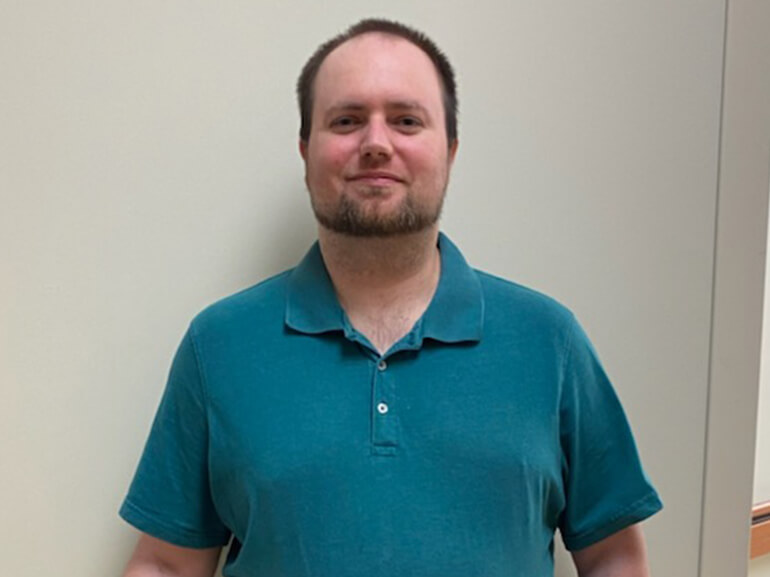Tyler's story

It was the evening of January 14, and 36-year-old Tyler Wibbenmeyer was in bed relaxing after a long day at work as an operations technician at a residential re-entry center (halfway house). The Missouri native, who in his spare time enjoys reading, playing video games, hunting, fishing and hiking, started experiencing headaches and dizziness. He got up to go to the living room when he suddenly became light-headed and his left side went numb. He stumbled against his closet door and fell back on his bed.
He was taken to a local hospital where they did a head CT scan and started IV blood pressure meds. Tests revealed Tyler had a stroke.
After two weeks in the hospital, Tyler was stabilized and ready for the next step in his recovery. He chose SSM Health Rehabilitation Hospital - Bridgeton for their expertise in stroke rehabilitation and their robotic assistive therapies, plus he would be able to have his family be an active part of his treatment.
When Tyler first arrived, he required maximum assistance just to get out of bed and take a few steps. He also needed help performing daily activities, such as dressing and bathing. His speech was also affected and he had difficulty with complex consonant sounds such as double letters. Even his last name was hard to say without slurring. His thought processes were also a little delayed, though he didn’t have any major cognitive issues.
His goal was to be as independent as possible and get around with a cane – not having to use a wheelchair or walker. He also wanted to be able to return to work and get as close to his pre-stroke life as possible.
Tyler’s physical therapists worked on getting him moving again. He used the Lokomat®, a robotic body weight support system, to begin walking through basic exercises, increasing distance and decreasing the need for help. To improve his arm and hand movement, therapists had him use the Armeo®Spring. This training device is equipped with a grip sensor that urged Tyler to squeeze his hand and interact with virtual objects.
In preparation for heading home, Tyler practiced going up and down stairs each day with a cane, as he does not have a railing on the three steps leading into his house. Additionally, he performed exercises to improve leg strength and endurance.
In occupational therapy, Tyler worked on the skills he needed to return home safely and independently, including balance, core strengthening and strategies to manage everyday tasks, from personal care to meal preparation. Therapists also focused on weight bearing, range of motion and gross and fine motor coordination activities to improve the use of his left arm and hand.
Tyler recalls two key milestones in his recovery. The first was when he was able to take independent steps with his left leg. “At that point I knew that eventually I’d be walking again,” Tyler said. The second was when he opened his fist unassisted. “When I was able to open my hand on my own, it allowed me to start working toward regaining manual dexterity and the ability to perform daily routine tasks.”
His family was a huge source of inspiration and encouragement. Tyler’s mom stayed with him for several weeks. His brother was also by his side and both attended therapy sessions. Because they live with Tyler, it was important for them to learn the techniques and strategies to help him when he returns home.
After 40 days in the hospital, Tyler was ready. He discharged on March 14, able to manage almost all his daily needs and get around with a cane, confident he’d soon be able to walk without a cane at all. He planned to continue his rehabilitation with home health services. He was most looking forward to seeing friends and family, getting back to work and having a sense of normalcy.
Tyler learned a lot about himself on this journey. “It’s important to always stay positive,” he said. “I would always compare my progress against the day after the incident and not the day before. It’s important to stay focused on the gains you’ve made, however small. Also, inform a nurse or doctor about any pain or discomfort that is persistent, because it might just save your life.”